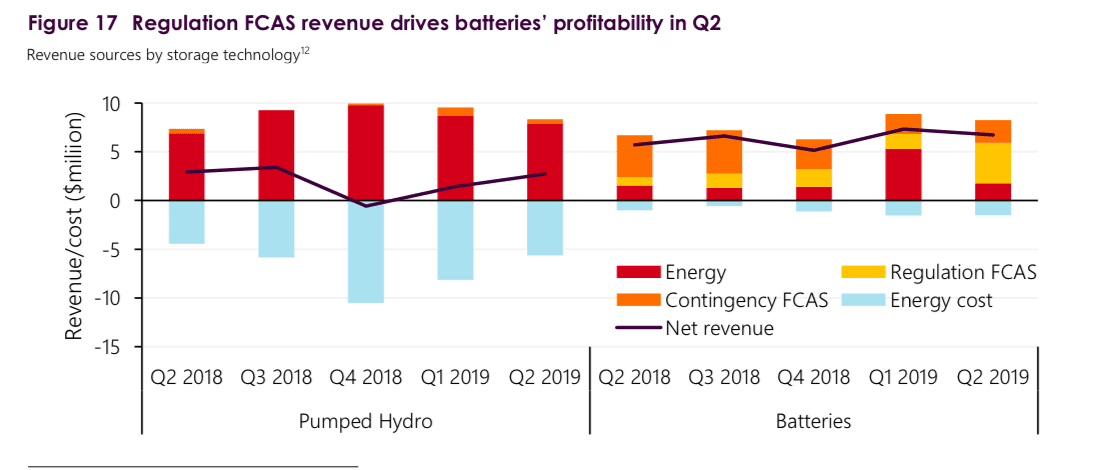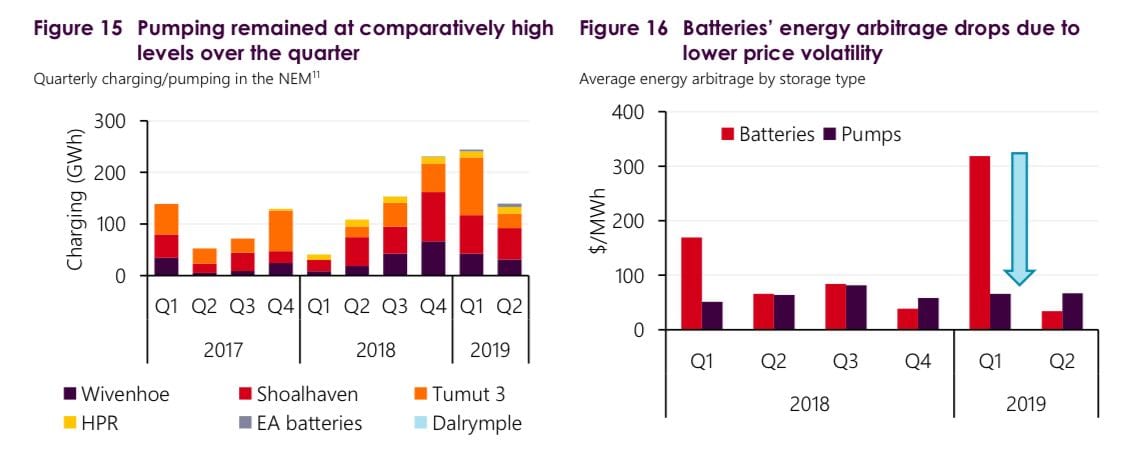Alinta sees sub 5-year payback for unsubsidised big battery at Newman
Australian
energy utility Alinta says it expects to get a sub five-year payback
for its ground-breaking big battery that is attached to the company’s
Newman gas fired generator in the Pilbara region of West Australia.
While nearly all the publicity on big batteries went to the Tesla installation at Neoen’s Hornsdale Power Reserve in South Australia, built in less than 100 days in late 2017, the Newman battery has been quietly demonstrating how batteries can reduce the need for back-up (yes, even fossil fuel generators need back-up), slash fuel costs and increase reliability.
The 35MW/11MWh Newman battery – using Kokam technology – was installed in September, 2017, before the 100MW/129MWh Tesla installation at Hornsdale, but like its larger peer has been delivering handsome returns for its owner. And in the case of Newman, there is no subsidy or government contract.
In an interview with RenewEconomy’s Energy Insiders podcast,
Alinta Energy chief executive Jeff Dimery says the “rough payback of
4.5 years, which he says in an excellent payback for this type of asset.
More than that, it has also delivered increased reliability and security for the Newman power station’s major customers, such as the Roy Hill iron ore mine owned by Gina Rinehart.
One of the great fallacy of the current energy debate is that only wind and solar energy need “back up”. This is complete nonsense. The Newman power stations has four different gas turbines, two of which usually have to be run all the time as spinning reserve just as back-up for the other one or two that may be required to generate electricity.
The presence of the battery means that spinning reserve is no longer required. Its speed of reaction and strength meant it could hold the grid together if the main turbine or turbine tripped, giving time for the other two to be fired up. This has significantly reduced outages at Roy hill.
“The whole role (of the battery) is to elimate spinning reserve, so we are not burining gas in standby mode,” Dimery says. “The leliability of supply has increased dramatically on the back of that investment.
“It’s much more than the financial rturn. It’s been very important for out customer for the security and reliability of supply,”
As a bonus, the Newman battery can do at least three things that were previously not seen with such installations: it can operate in standalone mode, it has grid-forming capability, and can provide frequency control by acting as a virtual generator. That is causing a rethink about the way that grids can be managed.
The results will welcomed by the proponents of other similar batteries on isolated grids and in mining operations, as well as the country’s major grids.
Dimery notes that the business model of batteries on the main grid, is evolving., The early batteries, like Hornsdale, have been making good money out of the frequency and ancillary services market (FCAS), but that has limited scope and is being cannibalised as more batteries join the grid.
Dimery says future batteries will have to make money in energy arbitrage, buying at times of low prices and selling (discharging) when prices are higher, usually in the peaks.
Alinta has also contracted to take the output from the 200MW Solar River project in South Australia, which is also contemplating a 100mW/300MWh battery.
“A number of batteries have done well around FCAS,” Dimery says. “The more batteries that go in to the market, the more that revenue strem will be cannibalised. The economics of that wont stack up over time. The long term future is about how you manage that energy storage and arbitrage.”

The difficulty of doing this is borne out in the latest data from the Australian Energy Market Operator. These graphs from its Quarterly Energy Dynamics publication above show the extent to which battery storage technologies are relying on the various forms of FCAS markets (see the graph on the right).
Energy markets, in the red, form little of their revenue pie, except in the summer months. Pumped hydro (graph to the left) do a lot of energy arbitrage, but don’t actually make much money out of it (black line). In the December quarter, they actually lost money and in the latest quarter, despite a lot of pumping, made a combined net profit of $2.7 million.

The next graph also points to the magic potion required to make money out of arbitrage – volatile prices.
But as AEMO notes, the battery revenue from energy arbitrage was significantly lower in the latest quarter, due to reduced price volatility in South Australia and Victoria.
While nearly all the publicity on big batteries went to the Tesla installation at Neoen’s Hornsdale Power Reserve in South Australia, built in less than 100 days in late 2017, the Newman battery has been quietly demonstrating how batteries can reduce the need for back-up (yes, even fossil fuel generators need back-up), slash fuel costs and increase reliability.
The 35MW/11MWh Newman battery – using Kokam technology – was installed in September, 2017, before the 100MW/129MWh Tesla installation at Hornsdale, but like its larger peer has been delivering handsome returns for its owner. And in the case of Newman, there is no subsidy or government contract.
More than that, it has also delivered increased reliability and security for the Newman power station’s major customers, such as the Roy Hill iron ore mine owned by Gina Rinehart.
One of the great fallacy of the current energy debate is that only wind and solar energy need “back up”. This is complete nonsense. The Newman power stations has four different gas turbines, two of which usually have to be run all the time as spinning reserve just as back-up for the other one or two that may be required to generate electricity.
The presence of the battery means that spinning reserve is no longer required. Its speed of reaction and strength meant it could hold the grid together if the main turbine or turbine tripped, giving time for the other two to be fired up. This has significantly reduced outages at Roy hill.
“The whole role (of the battery) is to elimate spinning reserve, so we are not burining gas in standby mode,” Dimery says. “The leliability of supply has increased dramatically on the back of that investment.
“It’s much more than the financial rturn. It’s been very important for out customer for the security and reliability of supply,”
As a bonus, the Newman battery can do at least three things that were previously not seen with such installations: it can operate in standalone mode, it has grid-forming capability, and can provide frequency control by acting as a virtual generator. That is causing a rethink about the way that grids can be managed.
The results will welcomed by the proponents of other similar batteries on isolated grids and in mining operations, as well as the country’s major grids.
Dimery notes that the business model of batteries on the main grid, is evolving., The early batteries, like Hornsdale, have been making good money out of the frequency and ancillary services market (FCAS), but that has limited scope and is being cannibalised as more batteries join the grid.
Dimery says future batteries will have to make money in energy arbitrage, buying at times of low prices and selling (discharging) when prices are higher, usually in the peaks.
Alinta has also contracted to take the output from the 200MW Solar River project in South Australia, which is also contemplating a 100mW/300MWh battery.
“A number of batteries have done well around FCAS,” Dimery says. “The more batteries that go in to the market, the more that revenue strem will be cannibalised. The economics of that wont stack up over time. The long term future is about how you manage that energy storage and arbitrage.”

The difficulty of doing this is borne out in the latest data from the Australian Energy Market Operator. These graphs from its Quarterly Energy Dynamics publication above show the extent to which battery storage technologies are relying on the various forms of FCAS markets (see the graph on the right).
Energy markets, in the red, form little of their revenue pie, except in the summer months. Pumped hydro (graph to the left) do a lot of energy arbitrage, but don’t actually make much money out of it (black line). In the December quarter, they actually lost money and in the latest quarter, despite a lot of pumping, made a combined net profit of $2.7 million.

The next graph also points to the magic potion required to make money out of arbitrage – volatile prices.
But as AEMO notes, the battery revenue from energy arbitrage was significantly lower in the latest quarter, due to reduced price volatility in South Australia and Victoria.
Giles Parkinson is founder and editor of Renew Economy, and is also the founder of One Step Off The Grid and founder/editor of The Driven. Giles has been a journalist for 35 years and is a former business and deputy editor of the Australian Financial Review.
-
State backs community solar plan to take Victoria town 100% renewableby Sophie Vorrath on 12 August 2019 at 2:47 PM
- Murdoch solar scare campaign called out by Clean Energy Regulatorby Sophie Vorrath on 12 August 2019 at 1:56 PM
- ACT awards new round of grants for household battery storage schemeby Michael Mazengarb on 8 August 2019 at 3:57 PM
-
The tech behind those 26 full throttle Porsche Taycan launchesby Bridie Schmidt on 12 August 2019 at 1:44 PM
-
Audi considers all-electric R8 supercar in collaboration with Rimacby Bridie Schmidt on 12 August 2019 at 12:24 PM
-
How electric, driverless cars could boost Australia’s economy by $92bnby Sophie Vorrath on 12 August 2019 at 12:03 PM





No comments:
Post a Comment